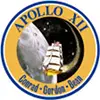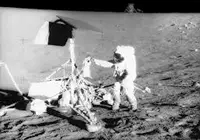Apollo 12 was the second mission to land people on the Moon. The 10-day mission ran Nov. 14–24, 1969. 
Commander of the Apollo 12 crew was Charles "Pete" Conrad, Jr. (right, left). Richard "Dick" Gordon (right, center) was the Command Module Pilot, and Alan Bean (right, right) was the Lunar Module Pilot. Both Conrad and Gordon were veterans of Project Gemini; Conrad was the pilot on Gemini 5, and he and Gordon had flown together on Gemini 11. Bean was making his first spaceflight. Blastoff was at 11:22 p.m. Eastern Time on Nov. 14, 1969. NASA waived weather rules and launched during a thunderstorm; the launch proceeded without incident, despite a lightning strike. (Bean and Conrad crawled into the lunar module to look for lightning-related damage; they found none.) 
Yankee Clipper was the name of the Command Service Module; the crew jettisoned the Service Module before re-entry. Intrepid was the name of the Lunar Module, which had an ascent stage and a descent stage (which was left on the Moon). The crew did three television broadcasts during their journey, showing the inside of the command module and shots of first the Earth and then the Moon. The lunar module crew of Apollo 12 improved on the landing achieved by the Apollo 11 crew of Neil Armstrong and Buzz Aldrin by landing very close to their intended target. The Surveyor III spacecraft had touched down on the lunar surface on April 20, 1967, and Bean and Conrad set down the lunar module just 600 feet away, in the Ocean of Storms, on November 19. They performed two moonwalks (with Conrad exiting the spacecraft first), totaling nearly eight hours, and deployed the nuclear-powered Apollo Lunar Surface Experiment Package, about 400 feet away from the Lunar Module. 
One piece of equipment deployed by the Apollo 12 lunar surface crew was the Solar Wind Composition Experiment. This was a repeat of what the Apollo 11 crew had done (and, in fact, the next three lunar missions repeated this as well). The Astronauts deployed an aluminum foil sheet that was exposed to the Sun for varying points of time, with the goal of capturing solar particles. The crew took the foil back to Earth so NASA scientists could do analysis. Other experiments measured the Moon's magnetic field and seismic activity. Bean and Conrad also collected samples of moon rocks, bedrock, and dust (including from an 8-inch-deep trench) and removed pieces of Surveyor 3 (including tubing and the TV camera and cables) to take back to Earth. This crew had carried the first color television to the lunar surface, and that was the camera that was mounted on the exterior of the spacecraft and had broadcast images of Conrad and then Bean descending to the lunar surface. However, they were unable to broadcast in color from the intended tripod site on the lunar surface because Bean inadvertently pointed the camera at the Sun, which zapped the camera's capabilities. They did take a large number of static photographs, of the lunar surface (searching for prospective future landing sites) and of Surveyor 3. After a seven-hour rest, Bean and Conrad flew back to rendezvous with Gordon in the Yankee Clipper. Their return to Earth was without incident. Splashdown was in the Pacific Ocean on November 24. The crew endured quarantine in Houston and were released on December 10. |
|
Social Studies for Kids
copyright 2002–2026
David White




